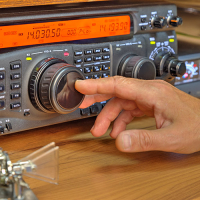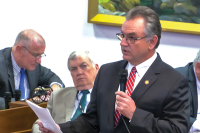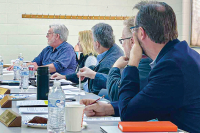A mutual enterprise
By Michael Beadle
Sometimes John Grant sees a bear inside a rough block of soapstone. Sometimes he sees a buffalo or an eagle.
“I’ll let the stone tell me what’s in there,” he said during a Saturday morning stonecarving demonstration at the Qualla Arts and Crafts Mutual in Cherokee.
Rather than sketching out designs in journals, Grant simply looks at a rough block of limestone, soapstone or alabaster to determine what figure waits inside to be carved.
“It’s strictly from the mind to the stone,” he said.
After working as a federal police officer for 23 years and then at Harrah’s Casino, Grant decided to focus more time on stone carving, a passion he’d first discovered while guarding Cold War nuclear bombs in the Air Force in California. Though a self-taught stonecarver, Grant attended the Institute for Native American Arts in Santa Fe to hone his skills and began a full-time career as a stonecarver in 2002. He’s won numerous awards for his carvings in Air Force and Cherokee competitions and plans to open a bronze foundry along with his brothers in the Big Cove community in order to produce larger pieces.
Related Items
Grant is one of many Cherokee artists who sell their artwork at the Qualla Arts and Crafts Mutual in Cherokee. The arts and crafts cooperative, located across the street from the Museum of the Cherokee Indian on the Qualla Boundary, is a treasure store full of finely crafted stone and wood carvings, hand-woven baskets, beaded jewelry, pottery, masks, pipes and much more.
In an age where mass-marketed, throw-away products are sold at the lowest price and customers have come to believe the best things in life are on sale, the Qualla Arts and Crafts Mutual takes pride in maintaining a thriving business where visitors and Cherokees can buy genuine, handmade arts and crafts that are one-of-a-kind wonders. While these arts and crafts may cost more than the trinkets and souvenirs sold in tourist shops, customers who come in the Cherokee co-op store can be sure the art they buy is the real thing.
To ensure the authenticity and honor the quality of Native American artwork, the Qualla Arts and Crafts Mutual board members — who represent various art forms such as woodcarving, stonecarving, ceramics, jewelry, and basket weaving — review several works from an artist and see the artist at work before recommending his or her work as worthy of the Qualla Mutual. Then the artwork receives a certification tag from the U.S. Department of the Interior. These tags are visible in the glass cases and display cabinets throughout the co-op store.
About 300 artists now sell their work in the spacious, tranquil galleries of the Qualla Arts and Crafts Mutual. Founded in 1946 as an artists’ cooperative, the shop sells the artwork of Cherokee as well as other Native American tribes.
“We’ve just got a variety of people that we work with,” says Vickie Ledford, the store’s current manager who has worked at the co-op for 20 years.
Cherokee artists involved with the co-op approach the business side of their craft in many different ways, according to Ledford. Some bring in their work every week. For others, it’s every month or twice a year. Some artists market their work in books and CDs while others, Ledford said, aren’t interested in the publicity — they’d rather make their art and have the co-op sell it.
“People are marketing themselves better now,” Ledford adds.
She credits an active Qualla Arts and Crafts Mutual board with promoting recent public demonstrations, which can offer the public opportunities to meet local Cherokee artists and learn about how traditional Cherokee crafts are made.
“And that helps us,” Ledford said.
The co-op gets additional assistance from the nearby Oconaluftee Village, where tourists can visit an authentic re-creation of a Cherokee village and learn the traditions of the Cherokee people before being directed to a place like the Qualla Arts and Crafts Mutual to buy authentic Cherokee and Indian art.
What is more, Ledford said, Cherokee High School graduates are now finishing school with the experience and knowledge of making traditional Cherokee crafts because those art skills are taught in the schools.
Over the years, the gallery space at the Qualla Arts and Crafts Mutual has expanded to include more room for artists to sell their work. In the newest gallery, a permanent collection is being prepared with glass-encased exhibits that honor prominent Cherokee artists such as potter Maude Welch; wood carvers G.B. Chiltoskey, Amanda Crowe and Virgil Ledford; and basket makers Edmund Youngbird, Eva Wolfe and Minda Wolfe.
Ledford delights in the fact that she is able to work with so many talented artists.
“It’s really an honor to be a part of it,” she said.
During a Saturday demonstration at the Qualla Mutual, several basket makers and a few carvers were on hand in the store’s permanent collection gallery.
Ramona Lossie, who weaves miniature rivercane baskets and pocketbooks, grew up with weaving and enjoys the challenge of crafting exquisite pieces that fit into the palm of your hand. The majority of her customers are collectors, she explained, with special interest coming from the Northern and Western United States.
Other basket weavers like Lucille Lossiah prefer to work with maple strips to create baskets, which normally take a few weeks to make. Natural dyes lend rich colors to the strips within the basket. Bloodroot gives an orange dye, butternut gives a black dye, and walnut lends a brownish tint. After decades of making baskets, weavers follow the process like a recipe that no longer requires looking over the directions.
“Either way you turn, it’s hard work,” said Lossiah, who has also done basket-making demonstrations at the Oconaluftee Village and teaches basket making classes throughout the year.
Some baskets have lids. Some have handles. They all appear too beautiful to use, but Cherokee artists maintain they are built to serve a utilitarian purpose. Though valued as works of art, they are also usable waste baskets, purses, fish baskets and market baskets.
Materials for making the baskets have gotten scarce, according to Lossiah. Some Cherokee basket weavers now have to go as far as Georgia to get rivercane. There’s been a concerted effort recently to preserve basket-making materials by planting rivercane and white oak.
The Qualla Arts and Crafts Mutual is open from 8 a.m. to 4:30 p.m. Monday through Saturday and 9 a.m. to 5 p.m. on Sunday. The store is closed on Sundays from January through mid-February. For more information or to order a catalog of the artists who sell their work at the Qualla Mutual, call 828.497.3103 or go to the Web site www.insidenc.com/mountain/quallacoop.htm.









